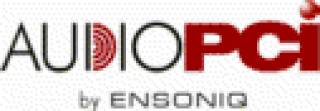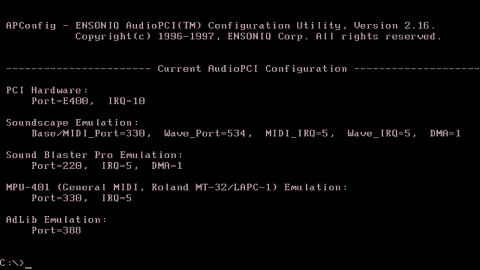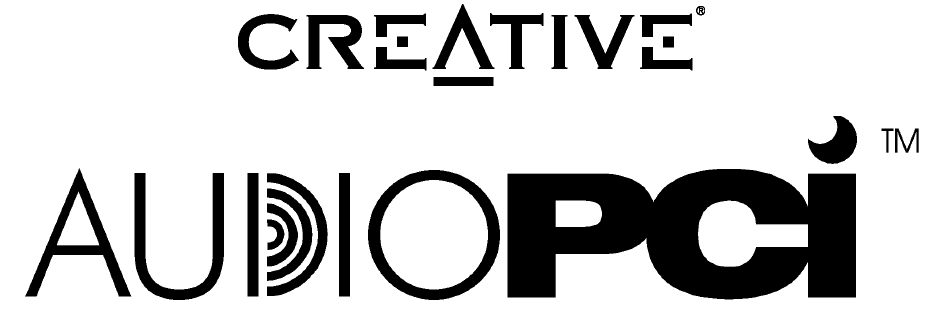 AudioPCI
AudioPCI
In 1997, Ensoniq introduced AudioPCI - a budget PCI sound card. At the time, the company was getting squeezed out of the market by Creative Labs, and so needed to change direction away from high-end audio and into the budget OEM market. For this new card they devised an ISA software audio emulation driver that was compatible with most DOS games. It was rare for PCI sound card manufacturers to bother with DOS compatibility now that Windows was taking over the world. To OEMs the card was sold for ~$50 USD a piece. For anyone else, closer to ~$80 USD.
The driver virtualised a Sound Blaster-compatible card through the use of Non-Maskable Interrupts (NMI), effectively capturing commands that would be send to an IRQ (Interrupt Request Line) and redirecting them to the AudioPCI card. After Ensoniq's takeover by Creative Labs, this driver was incorporated into the Creative Sound Blaster Live! (although while Creative added support for Sound Blaster 16 to this range of cards, they dropped support for the legacy Ensoniq SoundScape).
The Ensoniq AudioPCI DOS driver included Ensoniq Soundscape 16-bit digital audio and sample-based synthesis support, along with support for Sound Blaster Pro, AdLib Gold, General MIDI, and Roland MT-32. However, without actual hardware for FM synthesis, FM music and sound effects were simulated using samples, often with unacceptable results. Therefore, it was more practical to configure DOS games to utilize the General MIDI synthesizer and digital sound effects whenever possible for better sound quality.

HINT: The AudioPCI driver, APINIT, requires an Expanded Memory Manager (EMS) to be loaded, such as EMM386.EXE. If you have games that only work with XMS, be sure to load this with the 'NOEMS' argument, so the driver will still load for AudioPCI to work, but you will have XMS memory available.
At the heart of the first AudioPCI cards was Ensoniq's ES1370 chip. In order to keep the cost of manufacture and design way down, some of the handling of audio functions for this chip were handled by the host PC in software [the driver], not in the ES1370 chip. The ES1370 consisted of:
- a PCI Interface (including a memory cache/buffer for audio channels)
- a DMA controller
- Legacy Sound Card Support (Ad Lib, Sound Blaster, MPU-401, OPL-FM, WSS and SoundScape wavetable synth)
- a Codec (AK4531)
The legacy support above meant audio instructions that were received by the driver and handled in software were then sent to the card for audio output.
In reality the Sound Blaster emulation in DOS is not 100%, and numerous games will simply not detect the card. MIDI quality is good - the AudioPCI card does not have its own built-in patchset, instead relying on Ensoniq's software patchsets (called wavesets) that would be loaded into RAM - they made 2 MB, 4 MB and 8 MB patchsets. The 4 MB and 8 MB patchsets also supported the Roland GS standard.
Note that in some cases, OEM versions of the card did not allow for the 8 MB patchset to work. The Hewlett-Packard variant is one such card.
The card's signal-to-noise (SnR) ratio is very good - certainly much better than most Creative cards. In playback [digital-to-analogue] tests conducted by PCAVTech, it got a Signal-to-Noise ratio of -76dB - this is considered very good.
Remember that the distortion and frequency response shown is for a round trip through the card - using both the ADC and DAC components of the card. They are therefore showing about twice what one would see using this card as either a ADC or DAC.
Round-trip frequency response is smooth, and within +/- 0.2 dB up to 17.5 kHz. Two-way THD [Total Harmonic Distortion] at 1 kHz is 0.0051 %, and S/N is 74 dB.
Only the S/N is substantially poorer than the Turtle Beach Fiji to a degree that could be possibly audible with music. Of course, this card also lacks digital I/O.
This is all quite good performance, particularly considering the price."
PCAVTech
The Creative Labs CT5507 chip is a relabeled ES1370. Cards that used the ES1370/CT5507 chip include:
- Creative Labs Sound Blaster PCI 64
- Creative Labs Sound Blaster PCI 128
- Creative Labs AudioPCI 1000
- Creative Labs AudioPCI 3000
For ES1370/CT5507, the DOS drivers are:
VEN_1274&DEV_5000 - From Ensoniq's website
1370 - Original DOS drivers for AudioPCI (2 floppy disks)
Here are some pics of the DOS drivers installed and running:

Running APCONFIG with no arguments shows the current configuration, which is handy:

APMIX is a pretty simple DOS mixer tool (oh, and the MT32 Enable flag can be separately switched on and off using the command-line "MT32" utility):
I'm really impressed with the Ensoniq AudioPCI - as mentioned, it's a very clean card audibly, with almost no hiss or hum, and crystal clear notes. Despite the fact it uses a software wavetable that gets loaded into memory, it doesn't sound cheap.
 Following the first version of AudioPCI, Ensoniq released "AudioPCI 97" in the form of chip ES1371, which was their first AC'97-compliant chip. AC'97 stands for Audio CODEC '97, and was a multimedia sound card specification put together by Intel and others. Like the ES1370, ES1371 had the same four subsystems listed above, except the Codec was now AC'97-compliant. The Creative Labs CT5880 chip was a relabelled ES1371 but with added 5.1 channel output.
Following the first version of AudioPCI, Ensoniq released "AudioPCI 97" in the form of chip ES1371, which was their first AC'97-compliant chip. AC'97 stands for Audio CODEC '97, and was a multimedia sound card specification put together by Intel and others. Like the ES1370, ES1371 had the same four subsystems listed above, except the Codec was now AC'97-compliant. The Creative Labs CT5880 chip was a relabelled ES1371 but with added 5.1 channel output.
.jpg)
.jpg)
Creative Labs AudioPCI 5000, owned by DOS Days' contributor targeted
Cards that used the ES1371/CT5880 chip include:
- Creative Labs AudioPCI 5000 (OEM version for Gateway 2000)
- Creative Labs AudioPCI 5100
- Creative Labs Sound Blaster PCI 16
- Creative Labs Sound Blaster PCI 128 Digital
- Creative Labs Sound Blaster ViBRA 128
For ES1371/CT5880 DOS drivers are:
VEN1274&DEV1371 - From VogonsDrivers website
When Creative Labs acquired Ensoniq, they released a mildly updated version of the ES1371, called ES1373. The only real upgrade with the ES1373 was the added support of I2S In or S/PDIF Out.
Cards that used the ES1373 chip include:
- Creative Labs Sound Blaster (CT4810)
In 1999, Creative Labs Malvern (which was the former offices of the Ensoniq company that had been acquired) released the "Ectiva 1938" (EV1938) and "Ectiva 1958" (EV1958). These were basically single-chip versions of the AudioPCI 64 and AudioPCI 128 cards respectively, cost-reduced and based on the ES1371/ES1373 (register compatible).
EV1958 added V.90, V.80 and V.34+ modem connectivity functionality in addition to other telephony features like speakerphone, answering machine and tone and pulse dialling.
The EV1938 and EV1958 were also used for both integrated audio on laptops/motherboards and on cards. They supported only 2-channel audio, but did have Sound Blaster 16 compatibility. Cards that used the ES1373/EV1938 chip include:
- Creative Labs AudioPCI 5200
- Creative Labs Sound Blaster AudioPCI 64V (CT4730)
For EV1938/EV1958 drivers are:
SBPCI.7Z - From VogonsDrivers website. I don't know if these contain any DOS drivers.
For original datasheets, here are the links: ES1370, ES1371, ES1373

